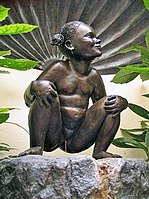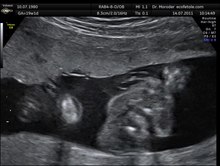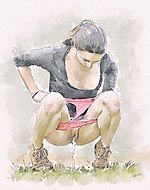micturition

|

|
|
|
Manneken Pis , arguably the most famous artistic representation of urination
|
Jeanneke Pis , the female counterpart
|
As micturition ( latin mingere , micturition ' , medical term) or urination , in the medical context, micturition and micturition called a form of is excretion from the human or animal body referred namely the emptying of the urinary bladder . It is excretion in liquid form, the urine . This process is controlled by complex control circuits of the autonomous and voluntary nervous system.
The micturition presupposes the following nerve mechanisms:
- Relaxation of the striated sphincter (via somatic innervation);
- Relaxation of the smooth muscles of the sphincter and opening of the bladder neck ( cervix vesicae ) (via a sympathetic innervation);
- Contraction of the smooth detrusor muscles surrounding the urinary bladder ( cervix vesicae ) (via a parasympathetic innervation).
Synonyms
In addition to the technical term micturition, there is a multitude of synonyms, some of which are frequently used regionally, some of which are vulgar and, depending on the situation, more or less adapted: emptying of the bladder, urination, urinating, urinating, leaking, peeing, peeing, pissing, lulling, rattling, seichen, beading , Ships, Brunzen (cf. wells as a euphemism in the 16th century for urine ), Brünzeln, Ludeln, Strullern, Pullern, Pritscheln or also “pee peeing” (for little boys / girls), “sometimes must”, “an Wiss make "(dialect in Francs).
Physiology of micturition
The urinary bladder serves as an intermediate store for the urine continuously produced by the kidneys , which is carried to it as secondary urine via the ureters . With normal fluid intake, it is usually emptied through the urethra two to six times a day . The amount of urine excreted is usually around 300 to 400 milliliters each ; however, there are no generally accepted values - some people pass over a liter of urine when using the toilet.
The urethra is the final stretch of urine excretion ; it is part of the urinary tract and begins at the lower end of the urinary bladder located in the pelvis . In male representatives it ends at the tip of the penis on the glans and in female in the vaginal vestibule .
The maximum bladder capacity is the filling volume which, when reached, leads to an imperative urge to urinate or an involuntary emptying of the bladder. For men, the normal value is given as 400 to 600 milliliters, for women a lower value (because the woman's internal sexual organs take up space) with 300 to 400 milliliters. However, these values vary greatly from person to person and there are no confirmed maximum values. It is calculated as the sum of the functional bladder capacity and the residual urine remaining in the bladder after micturition . The functional bladder capacity is the mean emptying volume.
The storage function of the bladder is ensured on the one hand by two sphincter muscles: an outer, striated, and an inner, consisting of smooth muscle cells. In addition, as the bladder filling increases, the "bladder emptier" ( M. detrusor vesicae , briefly referred to as detrusor ) has to adapt to the changed pressure conditions and relax. This is referred to as accommodation or compliance of the bladder. Interference in the interaction leads to a so-called detrusor-sphincter dyssynergy .
If the capacity for further accommodation of the detrusor is exceeded, there is a steep rise in pressure inside the bladder and via stretching receptors in the bladder wall to trigger the micturition reflex and thus to contraction of the detrusor, passive stretching of the internal sphincter and an arbitrarily controlled relaxation of the external sphincter .
The central control takes place in the pontine formatio reticularis . The parasympathetic nervous system is responsible for initiating the emptying process . It stimulates the bladder muscles to tighten and helps to empty the bladder. The sympathetic nervous system, on the other hand, ensures that the bladder relaxes in order to be able to fill up and to tighten the sphincter muscles . It thus prevents constant emptying.
Depending on the fluid intake, a healthy person produces around 1000 to 1500 ml of (secondary) urine in 24 hours, which he excretes two to six times a day. However, urine production is not the same at all times of the day. Most urine is produced by humans at six in the morning (see chronobiology ).
Development of bladder control
A control of the emptying of the bladder is obtained in the course of the child's maturation processes (or the " cleanliness education ") only after the control of the bowel movement . By the age of 5, around 80 percent of children are dry during the day and at night.
Fetal urination
The fetus urinates every hour and thus creates the amniotic fluid , which in turn is recycled through the fetal swallowing.
Micturition disorders
→ Main article: Bladder dysfunction as a collective term for bladder emptying and bladder storage disorders
A micturition disorder occurs mainly as wetting (enuresis) or as urinary incontinence in appearance and can be the cause of recurring urinary tract infections .
At any age, a multitude of causes can lead to bladder dysfunction (as a collective term for bladder storage and emptying disorders ), with nocturnal wetting in children, incomplete bladder emptying with residual urine formation , but above all involuntary urination, are particularly noteworthy in childhood .
Paruresis describes the inability to urinate for psychological reasons, in particular the inhibition to urinate in the presence of other people.
Socio-cultural factors
The social attitude towards the micturition process varies greatly between different epochs and cultures. On the one hand, this relates to the extent to which micturition is accepted in public. On the other hand, there are different norms for men and women regarding posture.
Posture when urinating
In Western cultures, men and women generally adopt the following positions to urinate: men urinate standing, women sitting or crouching . The differentiation is partly due to anatomical differences: Men find it easier to control their urine stream. However, there is also an intercultural variance in this regard . Herodotus reports from ancient Egypt that "[...] women let their urine stand and men sit up." In various other cultures , for example among some African ethnic groups , it is common for women to urinate while standing. These cultural differences, as well as the fact that women can learn special techniques for “standing pee”, show a strong cultural influence on posture and that these are learned behaviors. To urinate standing, women need the labia spread with two fingers and head for the top draw; thus the urine stream can be controlled.
In the western world, as in most other cultures today, a standing posture for men and a sitting or squatting position for women has established itself as the social norm .
In recent years, on the one hand, cardboard funnel systems ( Urinella ) have come onto the market that enable women to urinate while standing (so that they do not have to sit in a public toilet or can urinate more comfortably outdoors). Furthermore, women's urinals for public toilets were developed, which also make a (half) standing posture possible.
On the other hand, there is often a desire for men to want to sit on toilets (as opposed to urinals). This is due to the assumption that the distance to the toilet bowl would lead to inaccuracy and the associated contamination.
Public and private urination

Up until the 19th century, it was common in Western societies to urinate outdoors. With the increasing shift of life to the cities and the expansion of the sewage system ( sewage ), the urinal and toilet sanitary facilities were created in their current form. The fact that many people live together in a confined urban space and the associated increased need for hygiene and the desire to avoid odor nuisance led to a social sanctioning of public urination.
This is still valid today and is also legally sanctioned in some countries, for example in Germany as an administrative offense and in Austria as a violation of decency . However, especially at large events and when there are no or insufficiently available public lavatories, urination takes place in public, often increased by increased (alcoholic) fluid intake (for example at carnival, music festivals and at parties). To cope with this, public urinals have been installed in some cities with a pronounced nightlife, such as Amsterdam, which are pulled out of the ground in the evening and disappear into the sidewalk during the day.
With the increasing ban on urinating from public space and the "small business" being carried out in a toilet, urination became increasingly private in the Western European culture and also accompanied by a need for privacy. Many people find it uncomfortable or even impossible to urinate in the presence of other people. The use of a urinal represents a semi-public setting, insofar as other people are present, but the urinal itself is often provided with a privacy screen and only same-sex people are present.
Urinating and exercising
Glider pilots and paragliders can achieve unexpectedly long flight times and cool down a lot. Paragliders can only use gravity in the prone position to relieve themselves in the wind. Modern gliders have an outlet opening for a urine tube that can be reached in the cockpit floor.
Wet diving suits can have a pee opening with a zipper in the area of the groin. In a drysuit , a urinal valve ( English pee valve ) inside the front half to be installed thigh height, as a non-return valve acts and having on its inside a supply hose. A urinal condom for men can be connected to this and rolled up and glued to the penis, or a functionally analogous elongated, flat nozzle (funnel) for gluing (spray glue or brushing on) to the skin around the vulva with a hose outlet towards a narrow side. The alternative are absorbent diapers. Regarding the water balance, it should be noted that human skin in fresh water absorbs water through permeation . In particular in dry air, such as from a compressed air cylinder, the body loses water through breathing.
For women to pee on land while standing, there are narrow, funnel-shaped molded parts made of stiffer plastic or - for single use - made of plasticized cardboard (see Urinella ). These pieces are pressed against the vulva with the elongated opening in such a way that they seal and the outlet points forward and diagonally downwards. Trousers that are loosened by opening the fly can otherwise remain in the pulled-on position and thus continue to protect against cold, rain, wind and prying eyes. Urine drops can be shaken out of the removed funnel.
Wheelchair users typically use a urinary catheter or a urinal condom, women use the urinary catheter, which is shorter in this case, in conjunction with a plastic bag worn on one leg.
Artistic depictions of micturition
The depiction of people urinating is a recurring motif in art, especially since it is an everyday activity.
In the twentieth century in particular, urination was used as an artistic tool. Jackson Pollock urinated in a fireplace during a performance, Andy Warhol produced his famous oxidation paintings by urinating on canvases with members of the Factory . In Helen Chadwick's series of sculptures, Piss Flowers , bronze sculptures were made from the prints she made when she urinated in the snow with friends. Sophie Rickett's photo series Pissing Women depicts women who urinate while standing in various urban situations.
Various works of art related to this gained attention beyond the art scene. The work Piss Christ from 1987 by Andres Serrano depicts a crucifix in a glass in which the artist urinated. The work was perceived as a provocation by the Church and numerous religious people and condemned, including the Republican Senator Al D'Amato . Serrano received insults and death threats. The work was damaged by an opponent in 1997 in the National Gallery of Victoria . In 2011, the sculpture Pinkelnde Petra, made by Marcel Walldorf , caused a sensation in Germany. The sculpture shown at the Dresden Academy of Fine Arts shows a urinating policewoman in uniform. The police union and the Saxon Interior Minister Markus Ulbig felt provoked by the award-winning work , who interpreted the work of art as an insult to the officials . In 1979, the Brigantenbrunnen by the sculptor Gudrun Schreiner was set up on Ettlinger-Tor-Platz in Karlsruhe ; it is also called the "pee fountain" and shows a group of boys peeing at competition.
Peeing farmer's wife - drypoint by Rembrandt van Rijn (1631)
The pissing farmer - lithograph by Adriaen van Ostade (1660)
La Grande Danse macabre des vifs - Illustration by Martin van Maële (1905)
Urination in animals
Micturition occurs in all mammals and serves primarily the same purpose as in humans; the excretion of urinary metabolic products . In addition to the function of excretion, the urine, or more precisely certain substances it contains, the pheromones , also serves to mark territories in numerous territorial animals. In the case of small rodents , the urine or pheromones can also be used as a route marker. Animals that use their urine for marking purposes often have an intense, pungent odor (see also Jacobson organ ).
The amount of urine excreted depends on the body size; adult elephants can drain approx. 30 liters of urine at a time. The micturition time, however, is similar in all larger mammals (from approx. 3 kg) and averages approx. 21 seconds. During hibernation (around four months), polar bears do not urinate at all.
- Mammals urinating
Zebra ( Equus zebra )
Male horse
Maned Wolf ( Chrysocyon brachyurus )
Wolf ( Canis lupus ) the deposition of urine is also used for territorial marking ( pheromones )
See also
literature
- Klinke, Silbernagl: Textbook of Physiology . 4th edition. Georg Thieme Verlag, Stuttgart 2004, ISBN 3-13-796004-5 , p. 300 f.
Web links
Individual evidence
- ^ Karl Ludwig Sailer: Health care in old Bamberg. Dissertation, Erlangen 1970, p. 51.
- ↑ Stephan Heinrich Nolte : Psychosomatic view is missing. In: Deutsches Ärzteblatt. Volume 116, Issue 29 f., (July 22) 2019, p. 506.
- ↑ a b c d Bettina Moellring: Toilets and urinals for women and men (PDF; 3.5 MB) Diss. Universität der Künste Berlin 2004 Toilets and urinals for women and men urn: nbn: de: kobv: B170-opus-82 urn : nbn: de: kobv: b170-opus-82
- ^ Intersex Surgery, Female Genital Cutting, and the Selective Condemnation of "Cultural Practices" . (PDF; 525 kB) “Interestingly, I can report, based on having lived in a small village in Togo, West Africa, that West African women used to urinate standing up, and many still do - although the practice appears to be decreasing, perhaps as a result of Western influence. "
- ↑ Woman's Guide on How to Pee Standing ( Memento from September 2, 2004 in the Internet Archive )
- ↑ Standing pee for women
- ↑ Klaus Schwerma: Standing pee - the last bastion of masculinity , Kleine Verlag, 2000 ( Memento from May 2, 2002 in the web archive archive.today )
- ↑ Reviews and happy girls She-P.com, accessed November 8, 2016. - Contribution by glider pilot Vlada.
- ↑ She-p Pee-valve for women Manufacturer She-P, from around 2008/2009, accessed November 8, 2016.
- ↑ GMSD interviews woman who set record for longest scuba dive ( memento from November 8, 2016 in the Internet Archive ) kusi.com, July 12 and 19, 2015, accessed November 8, 2016. - Woman completed a 51-hour stay under water with Compressed air breathers and collects their urine in a bottle.
- ^ A b Alison Young: Judging the Image: Art, Value, Law. Routledge, 2005, ISBN 0-415-30184-X
- ↑ Piss Christ and the Serrano Controversy - A theological defense ( Memento of March 2, 2011 in the Internet Archive )
- ↑ "The women are on my side" - Der Spiegel
- ↑ Excitement about the peeing Petra - The time
- ^ Brigantenbrunnen in the Stadtwiki Karlsruhe
- ↑ Patricia J. Yang, Jonathan C. Pham, Jerome Choo, David L. Hu: Law of Urination: all mammals empty their bladders over the same duration . In: arXiv physics, q-bio . March 26, 2014, arxiv : 1310.3737 (English, first edition: 2013).













